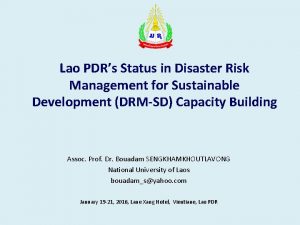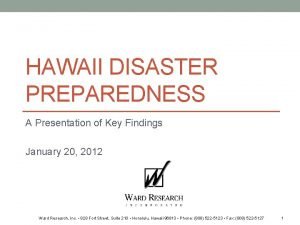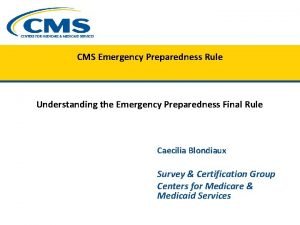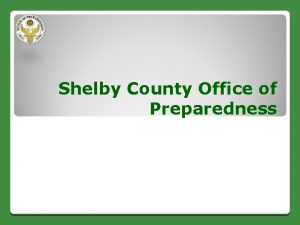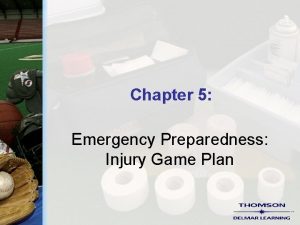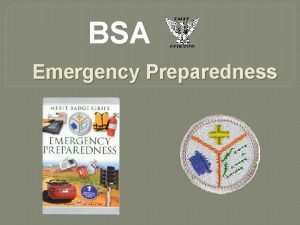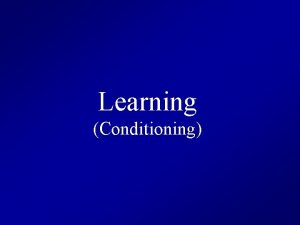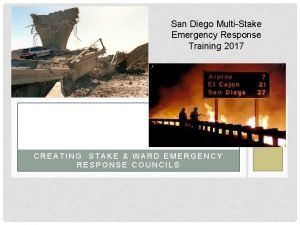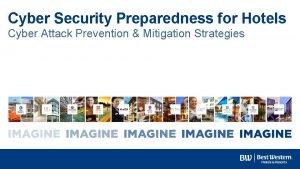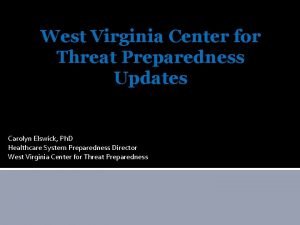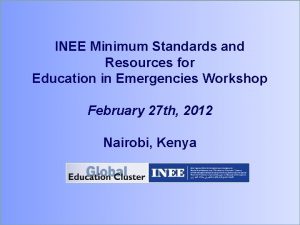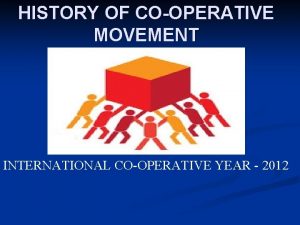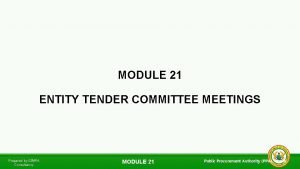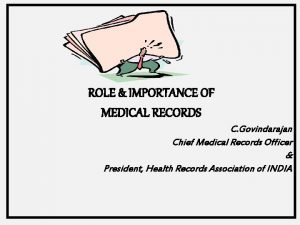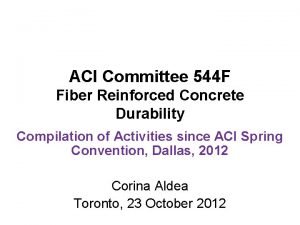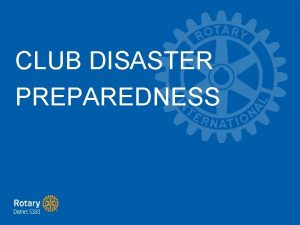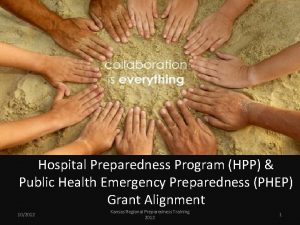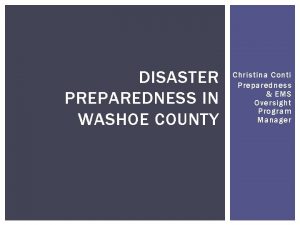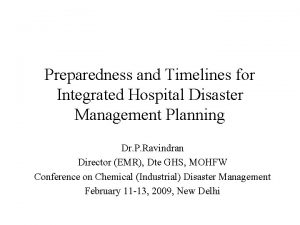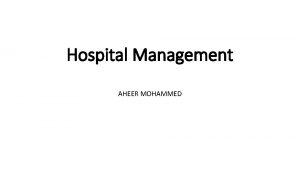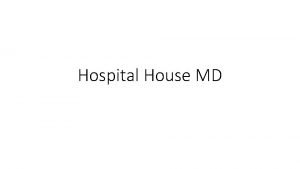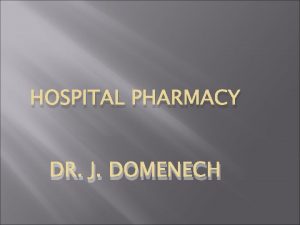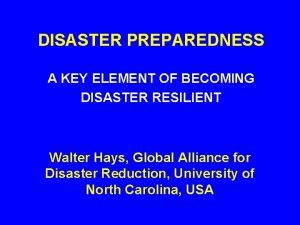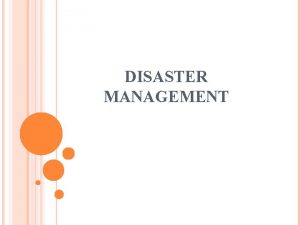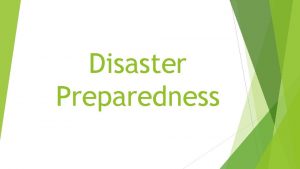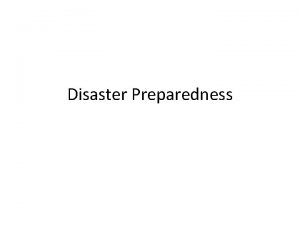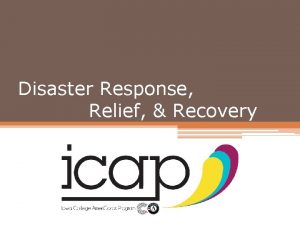Hospital Disaster Preparedness Special Committee on Disaster Preparedness



































- Slides: 35

Hospital Disaster Preparedness Special Committee on Disaster Preparedness Planning December 13, 2006

What We Are Preparing For: All Hazards Bioterrorism, Other Infectious Disease Outbreaks, and Other Public Health Threats and Emergencies

Goals of Preparedness Enhance our surge capacity response Collaboration and integration of plans of all emergency response partners Ability to maintain services in a sustained event

“Dual Use of Funds” Philosophy “Preparing for the unthinkable will prepare us for the most likely”

What Are Our Preparedness Efforts?

Recipients of HRSA* Funds • • • Hospitals EMS Community Health Centers Tribal Health Clinics Healthcare Facilities (nursing homes, assisted living, etc) (limited funding) • Physician Offices (limited funding) *HRSA: Health Resources and Services Administration (DHHS)

Personal Protective Equipment § Personal Protective Equipment for biological events is stockpiled in the 7 regions § Rural regions have 20, 000 changes + § Urban regions have 50, 000 changes + § There is a state stockpile of an additional 1, 000 “kits” (airborne, contact and droplet precautions) §One kit serves 25 patients for one day § Hospitals have also received Medical PAPRs §recommended for aerosolized procedures

Airborne Infectious Isolation (AII) Capacity • Most hospitals have reached the State Goal of: • • • 2 AII rooms in the Emergency Department 1 AII room on the Medical Surgical Unit 1 AII room in the Intensive Care Unit AII rooms with 1 ante room per 100 staffed beds 2% of all staffed beds are AII • Increase from 400 AII rooms to 1200 AII rooms • Creation of additional 670+ NPSC rooms

Clinic Demonstration Project • • Single Entrance Capability Lockdown Capability Triage Area Waiting Rooms Mechanical Ventilation AII Rooms Education/Training Patient Flow • Administration – – – Respiratory Etiquette PPE Education Surveillance Surge Capacity • Reports – Implementation Issues – Incremental Costs – “One Year After” Report

Inpatient Surge Capacity • May 2004 Exercise – 11, 000 staffed beds – 11. 000 surge beds • 4, 100 surge beds pre-positioned at hospitals (built to certain clinical specifications) 20% have mattresses • Inpatient and Outpatient Surge Capacity Plan

IP/OP Surge Capacity Plan • Assignment of beds, staff, supplies and equipment, base don Level of incident • Beds designated for RED, YELLOW and BLACK patients • GREEN patients to be treated at Alternative Outpatient Treatment Sites

Chemical Decontamination All hospitals have a portable decontamination shelter …decontamination suits …pre and post decon patient kits …decontamination training Funds available to construct/renovate fixed decon rooms

Chem. Packs are placed strategically throughout the state, containing nerve agent antidotes. Chem. Packs are available within 1 hour of request --- There are HOSPITAL packs (immediate and long-term treatment) --- There are EMS packs (immediate treatment in the field)

Incident Command System ICS is the structure used by all emergency responders Hospitals are required to be compliant with the “National Incident Management System” (NIMS) Elements 7, 9, 10, 11 in order to receive federal funds after August 31, 2007 All hospitals have adopted the top 8 positions

Regional Trauma Advisory Councils EMS and First Responders are being trained in the Wisconsin EMS Emergency Preparedness Plan …including training for triage, using START and Jump. START (pediatric) protocols START: Simple Triage and Rapid Treatment and also Pediatric education for Pre-Hospital Professionals (BLS and ABLS)

“Triage Tuesday” • On one designated day all patients brought by ambulance along with those coming to the hospital ED will be “triaged and tagged” • Purpose: better integration of EMS and hospital triage

Interim Pharmaceutical Stockpile • Interim Pharmaceutical Stockpiles (IPS) are strategically placed around the state • The IPS can be deployed within 4 hours of request • IPS contains – Amoxicillin – Doxycycline – Ciprofloxacin – (no pediatric dosages at the present time; instructions for dispensing in tablet format)

IPS Pharmaceuticals • Intended recipients: – Hospital staff and family – Medical Staff and family – First Responders and family • Purpose: maintain integrity of healthcare and critical services infrastructure • Strategic National Stockpile (SNS) arrives within 12 hours with medications for the general public (to be dispensed by public health)

Hospital Laboratory Preparedness Wisconsin State Laboratory of Hygiene has trained hospital labs in the packaging and transport of biological and chemical specimens Funding for Bio. Safety Cabinets and centrifuges with sealed carriers has been provided

Electronic Laboratory Reporting • 11 pilot projects: 9 hospitals and 2 clinics (more to follow) • “Lessons Learned” will help to establish real-time electronic laboratory reporting of communicable diseases to the State Health Department • Other surveillance projects are being funded by public health such as WEDDS, Electronic Health Record, Electronic Death Record

Communications Redundancy • 4 levels of communications redundancy – Landlines and cellular telephones – UHF/VHF two-way radio – Satellite Telephones (voice, email, data) – Amateur HAM Radio (internal and external communications) • Interoperability Plans

Legal Workgroups • Follow-up to issues not addressed in “Hospitals’ Guide to Mass Casualty Incidents” – a summary of federal and state law re: emergencies • Guide can be found at www. mbf-law. com • Phase II: identification of unresolved issues

State Expert Panels • … on Physician Offices – Infection Control Measures – Unusual Occurrences – Mass Casualty Guidelines – Alerting Protocols • … on Management of Decon Effluent: (each hospital to meet with its POTW to establish a plan)

State Expert Panels • … on Disaster Reimbursement (dialogue between payors and providers – Billing and Coding Issues • …on Dispatch (consistent protocols for Dispatch in a mass casualty incident – any incident involving 5 or more patients being transferred to one or more hospitals)

State Expert Panel • …on Evacuation of Hospitals and Other Healthcare Facilities (one consistent state-wide protocol for shelter-in-place or evacuation) • … on Pediatric Preparedness (hospital and EMS ) – “Midwest Pediatric Resources Directory” – Patient Tracking (in progress) – “Pediatric Guidelines” (in progress) – “Patient At Risk (in progress)

State Expert Panel • … on Materials Management (supplying hospitals in a mass casualty incident) • … on Human Resources (protocols for the deployment of volunteers and a policy for your staff who choose to serve as volunteers) • … on Ventilator Capacity (enhancing the ability of hospitals to provide positive pressure ventilation)

State Expert Panel • … on Disaster Ethics (addressing the multitude of decisions that will need to be made regarding triage, resource allocation and so much more) • … on Healthcare Facilities (assisting nursing homes, assisting living facilities and other such facilities enhance their preparedness levels) • … on Radiation Emergencies (protocols for hospitals, physician offices, EMS for the management of patients exposed to radiological agents)

Wisconsin Disaster Credentialing • A web-based, password-protected system to allow for – Primary Source Verification (all licensed HCWs) – Verification of quality and competency (physicians) – In compliance with JCAHO standards for Disaster and Temporary Privileging • Available to all hospital and local health departments • Wisconsin Emergency Assistance Volunteer Registry (WEAVR)

Burn Plan • There are limited burn beds in Wisconsin (Madison and Milwaukee) • Proposal is to establishing holding hospitals where there is trained staff (HRSA funded) to maintain patients for 72 hours before transfer to a burn center in collaboration with the American Burn Association

Physician Disaster Preparedness Education • Provide education to 2, 000 clinics • Goals: – Establish/reinforce Infection Control relationships – “Infection Control Measures for Physician Offices” – Mass Casualty Checklist – Health Alert Protocols

Pandemic Flu • Hospital Pandemic Flu Policy and Protocols for – Pre-Pandemic Phase – Post Pandemic Phase • Issues addressed in each Phase: --- Surveillance --- Emergency Response --Communications --- Vaccine ---Antiviral --- Clinical Practice

Minimum Level of Readiness Indicators • Your obligation is to be in compliance with these Indicators as appropriate for your type of facility • Further Indicators are being added: 1) training competencies, 2) management of radiological incidents, 3) Chem. Pack Distribution, 4) Behavioral Health, 5) Risk Communications, 6) Evacuation, 7) Patient Tracking, 8) Ethics, 9) Materials Management

Healthcare Leadership • “To think that the worst will not happen is natural… • . . . to lead in preparing for the worst is a moral imperative. ”

Local Healthcare Is Critical • Despite all the preparations at the State or National level, • Every disaster is LOCAL. • What matters most to the community is not the state and national response. . . • …what will save lives is the response of the local organization

Contact Information Dennis Tomczyk Director, Hospital Disaster Preparedness Wisconsin Division of Public Health 608 -266 -3128 tomczdj@dhfs. state. wi. us
 Conclusion on disaster management ppt
Conclusion on disaster management ppt Hawaii disaster preparedness
Hawaii disaster preparedness Hospital committee structure
Hospital committee structure Hospital pharmacy defination
Hospital pharmacy defination 1achors
1achors Cms emergency preparedness final rule
Cms emergency preparedness final rule Shelby county office of preparedness
Shelby county office of preparedness National radiological emergency preparedness conference
National radiological emergency preparedness conference Biological preparedness
Biological preparedness Nfpa 1600
Nfpa 1600 Chapter 5 emergency preparedness injury game plan
Chapter 5 emergency preparedness injury game plan 4 quadrants of operant conditioning
4 quadrants of operant conditioning Chapter 36 emergency preparedness and protective practices
Chapter 36 emergency preparedness and protective practices Do. 27 s. 2015 promoting family earthquake preparedness
Do. 27 s. 2015 promoting family earthquake preparedness Define disaster management
Define disaster management Bsa emergency preparedness
Bsa emergency preparedness Chapter 36 emergency preparedness and protective practices
Chapter 36 emergency preparedness and protective practices Biological preparedness
Biological preparedness Stake emergency preparedness plan
Stake emergency preparedness plan Data breach preparedness
Data breach preparedness Observational learning theory
Observational learning theory Nfpa business continuity
Nfpa business continuity West virginia center for threat preparedness
West virginia center for threat preparedness Preparedness mitigation response recovery
Preparedness mitigation response recovery Global pandemic preparedness
Global pandemic preparedness Karve committee on cooperative principles
Karve committee on cooperative principles Priia 305
Priia 305 Nye committee wwii
Nye committee wwii Ieee transformer committee
Ieee transformer committee Entity tender committee
Entity tender committee Conclusion of indian education commission 1964-66
Conclusion of indian education commission 1964-66 Budget steering committee
Budget steering committee Importance of medical records department
Importance of medical records department Creep committee
Creep committee Portfolio committee on mineral resources and energy
Portfolio committee on mineral resources and energy Aci 544
Aci 544
